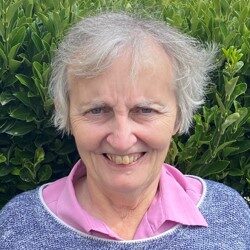In 1884, the Sisters of Mercy, Callan opened St. Brigid’s Missionary School with the aim of providing education and training for girls and young women who had a missionary vocation. St. Brigid’s was the only institution of its kind in Ireland and in the 75 years of its existence almost 2000 aspirants went through its doors.
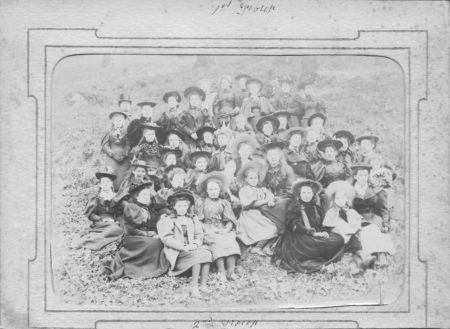 Aspirants from St. Brigid’s Mission School and children from St. Anne’s School, Callan on a picnic in Woodstock, Co Kilkenny
Aspirants from St. Brigid’s Mission School and children from St. Anne’s School, Callan on a picnic in Woodstock, Co Kilkenny
St. Brigid’s was part of the resurgence in missionary activity in the Irish Catholic Church. The Callan Foundress Mother Michael Maher had a life-long desire to serve on the missions and saw the need for a pre-novitiate for prospective missionaries. She was supported in her endeavour by local Bishop, Dr. Patrick Moran of Ossory.
The first aspirants were enrolled on 7th January, 1884, a few weeks prior to Moran’s appointment as Archbishop of Sydney. Given Moran’s connection to Callan, it is unsurprising that the first graduates, Maggie (Sr. M. Ita) Morris from Callan, Mary Anne (Sr. M. Magdalen) Meaney from The Curragh, Co Kildare, Hannah (Sr. M. Brigid) Looney from Macroom, Co Cork and Ellie (Sr. M. Patrick) Dwan from Moneygall, Co Tipperary entered with the Sisters of Mercy in Singleton, New South Wales. Sadly, Sr. M. Patrick Dwan was to die in 1891, aged 25 and three years Professed.
A school brochure outlined the purpose that St. Brigid’s sought to fulfil.
Many religious communities abroad are most anxious for Postulants but they do not wish to bring them out direct from their homes at the risk of having to send them back again in the event of not having a true vocation. A kind of preliminary Novitiate at home is needed to meet such cases. This want, the Callan missionary School undertakes to supply. It will test the vocations of these girls, ascertain their aptitude for various Religious Orders, supply any deficiency in their education, give them a training in the art of teaching and furnish a solid foundation for the Religious Life. Girls who believe they have a vocation and are not qualified to enter at once, can, by spending a short time at Callan, be introduced to some suitable convent.
An entry in the Catholic Directory 1895 outlined the curriculum in St. Brigid’s.
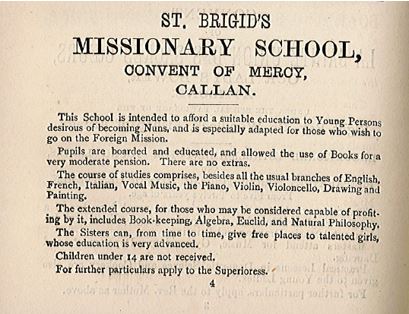
This school is intended to afford a suitable education to young persons desirous of becoming Nuns and is especially adapted for those who wish to go on the Foreign Mission. Pupils are boarded and educated, and allowed the use of books for a very moderate pension. There are no extras. The course of study comprises, besides all the usual branches of English, French, Italian, Vocal Music, the Piano, Violin, Drawing and Painting. The extended course, for those who may be considered capable of profiting by it, includes Book-keeping, Algebra, Euclid and Natural Philosophy. The Sisters can from time to time, give free places to talented girls, whose education is very advanced. Children under 14 are not received.
Our primary source for information on those who enrolled in St. Brigid’s is two registers. These record, name, address, date of admission, age, date of departure, congregation entered, destination and religious name. I am compiling a database of the registers and to date have added 1014 entries from January 1884 to September 1923. The database helps us to search and retrieve data on individual aspirants in response to research enquiries, but also allows us to analyse the information in greater detail.
A breakdown of the 1014 entries from 1884 to 1923 reveals that 329 entered with the Sisters of Mercy, 198 went home, 61 entered with the Presentation Sisters, 32 with the Dominicans, 30 with Holy Family, 22 with St. John of God, 21 with Sisters of Charity of the Incarnate Word, 16 with Good Shepherd Sisters, 14 with Sisters of St. Joseph, 14 with Franciscan Sisters, 10 with Ursuline Sisters, 10 with Our Lady of Charity and 8 with the Bon Secours Sisters. Smaller numbers entered with a range of other congregations.
Almost 20% of the 1014 went home. Some were described as delicate, presumably their health was not deemed sufficient to the task. Others perhaps found that religious life was not for them or needed more time to consider their vocation.
Their destinations were primarily within the Anglophone world. The greatest number went to Australia (169), followed by the United States of America (164), Ireland (140), South Africa (64), England (60), Canada (18), New Zealand (15). There were more diverse destinations, albeit on a smaller scale; 14 to India, 13 to Holland, 12 to France, 7 to British Guiana, 7 to Argentina, 5 to Java (now part of Indonesia), 5 to British Honduras, 4 to Belgium and 1 to Burma.
The aspirants came from all over Ireland, with the majority from the midlands and south; Cork (111), Tipperary (105), Kilkenny (101), Limerick (68), Clare (61). Laois (54), Dublin (52), Kerry (48), Offaly (47), Wexford (35).
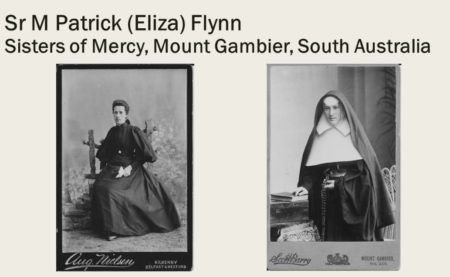
Most were aged between 16 and 21, with a smaller cohort in their mid to late 20s, and 40 in their 30s. The time spent in Callan varied, possibly according to the age, educational level and abilities of the aspirants, and to the needs of their prospective congregations.
While the registers are an invaluable source of information, we are fortunate indeed that the Callan community had the foresight to retain an accompanying collection of 200 approx. photographs. These images date from the late 1880s to the early 1920s and comprise studio portraits of aspirants, images of them as Postulants and Professed Sisters and photographs of the convents they entered and the ministries they undertook.
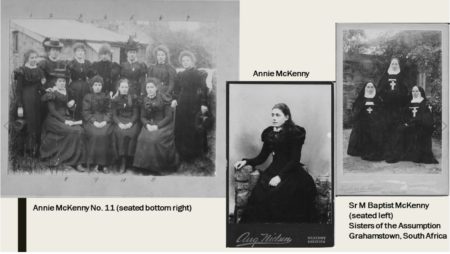
Using the database, we have been able to match the images with their individual entries in the register. In some cases, we have identified before and after images as in the case of Annie (Sr. Baptist) McKenny from Ballinahinch, Co Down who enrolled in Callan on 7th January, 1899 and left on 9th August, 1899 to enter with the Sisters of the Assumption, Convent of Good Hope, Grahamstown, South Africa. In a similar vein, Eliza Flynn of Shandon Square, Clonakilty, Co Cork entered St. Brigid’s in January 1896 aged 22 and left in September 1896 to join the Sisters of Mercy in Mount Gambier, Australia.
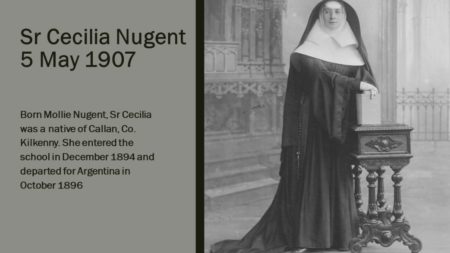
The collection includes photographs of convents abroad, some sent by graduates of Callan showing their new life, such as Mollie (Sr. Cecilia) Nugent from Co Kilkenny, who entered St. Brigid’s in December 1894 and left for the Convent of Mercy, Buenos Aires in October 1896. Others were sent by convents seeking Postulants, perhaps as a form of sales pitch, a visual representation of the missionary life on offer.
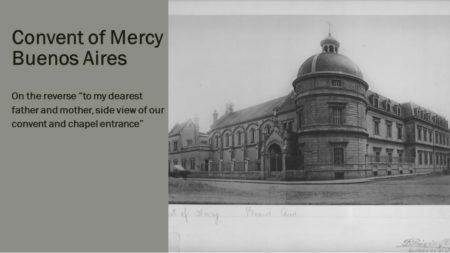
In one photograph we see a convent in New Zealand. On the reverse it reads “Holy Cross Convent, Epsom, opened 3rd May 1921, a suburb of Auckland, on the north island, hot & cold water, electric light & all modern conveniences, but school & church still to be built! Wanted 6 Postulants to fill the places of the Sisters sent there from St. Mary’s Ponsonby. Callan girls preferred!”
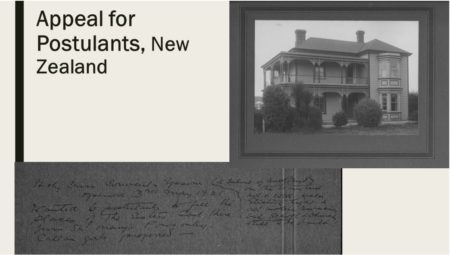
Of equal interest are photographs from the Sisters of Charity of the Incarnate Word, Texas featuring Sister Nurses in an operating theatre in Galveston, Texas.
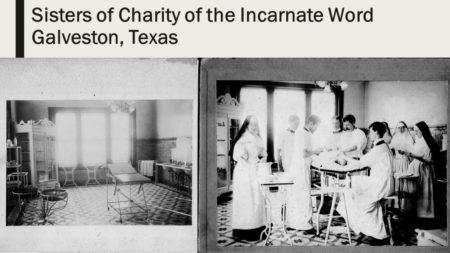
Callan in turn could use these images to prepare aspirants for missionary life, promote the missionary school and foster vocations.
By the 1950’s, numbers enrolling in Callan were dwindling. Missionary congregations had established their own Juniorates or Novitiates in Ireland, secondary education was more readily available and the Callan community saw there was no longer a need for a school exclusively for girls with a religious vocation. St. Brigid’s Missionary School closed in 1959, having contributed much to the Irish Church and to the missionary vineyard.
Marianne Cosgrave
Congregational Archivist
Sources:
Archive, Convent of Mercy, Callan
St Brigid’s College Callan, Golden Jubilee Book, 1999
Catholic Directory, 1895
Presentation by Sarah Gallagher, Archivist, MCA, February 2018

